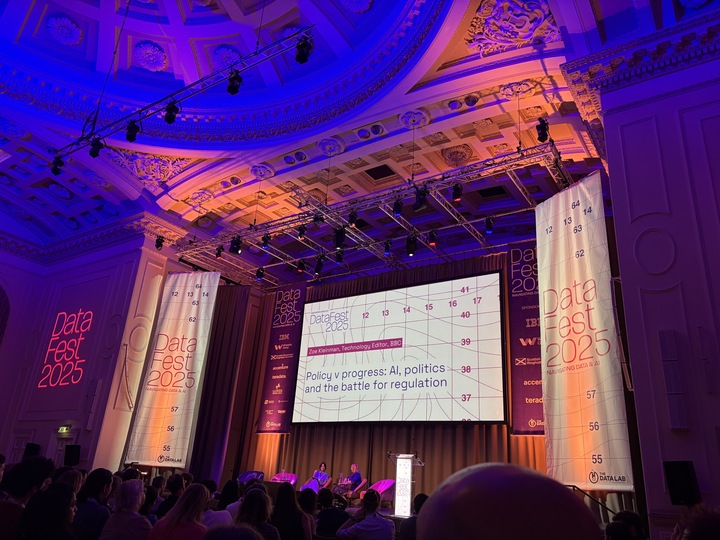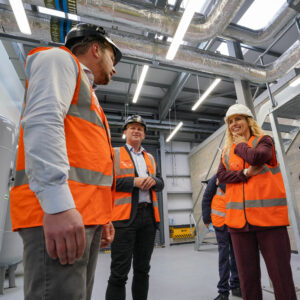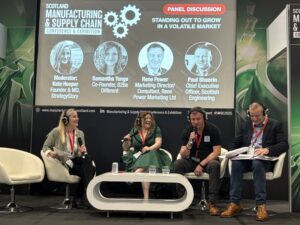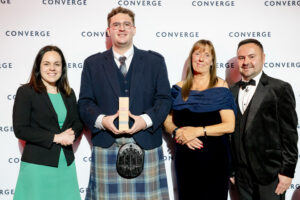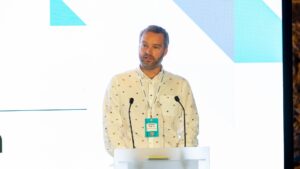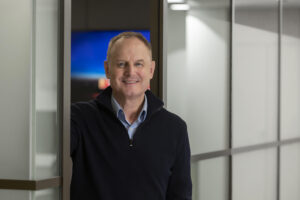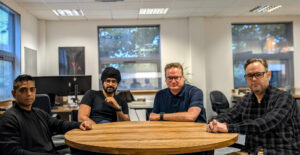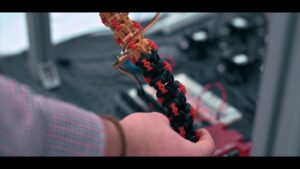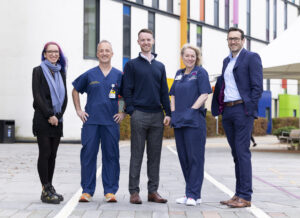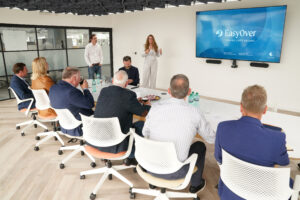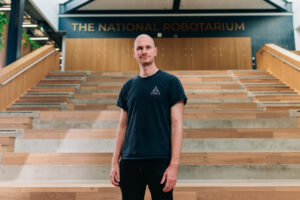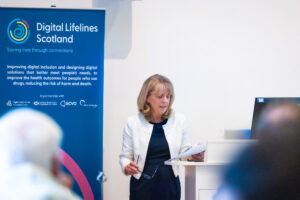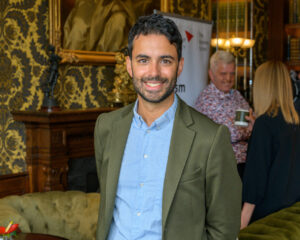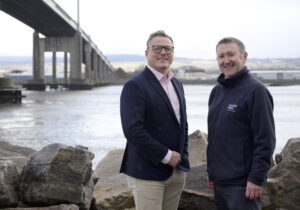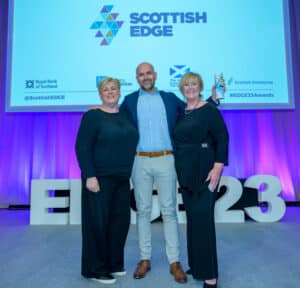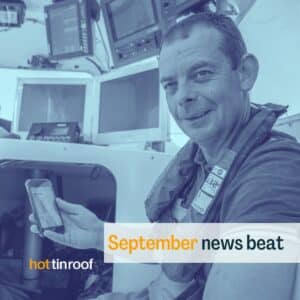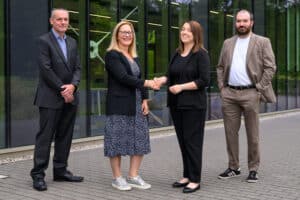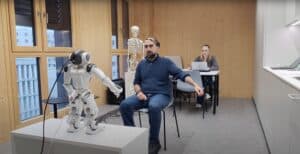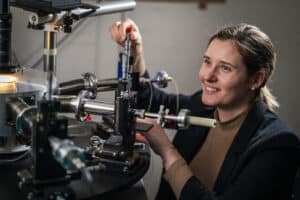Imagine throwing the brightest data scientists, AI wizards, and tech entrepreneurs into a room with enough caffeine to power a small nation – that’s DataFest 2025. As a PR professional accustomed to translating tech-speak across various channels and media platforms, attending this data extravaganza felt like Christmas. But I quickly realised I had a lot to learn from the expertise in the room.
“Have you tried implementing a multi-modal transformer for that?” someone casually asked me at the coffee station, apparently mistaking my “I’m here for the free pastries” expression for that of a fellow data scientist. I mumbled something about “exploring various architectural paradigms” before retreating to safer conversational waters with a fellow comms professional on one of the stands. It’s fair to say I learned a lot in a very short space of time!
Over the day, I oscillated between moments of genuine enlightenment and periods of nodding enthusiastically while my brain quietly blue-screened. But beneath the jargon, there were many genuine insights worth sharing:
1. AI is solving real-world problems (with real-world limitations)
BBC Technology Editor Zoë Kleinman cut through the hype with a refreshingly grounded keynote on AI applications that are tangibly changing lives. Her standout example? AI systems that spotted early breast cancer symptoms in 11 women that human doctors had missed during routine mammograms.
The catch? Data protection laws prevented the system from knowing patients’ medical histories, leading to hundreds of false positives. This encapsulation of AI’s current state – simultaneously miraculous and frustratingly limited – reminded me that the best tech stories aren’t about flawless solutions but about human ingenuity tackling real-world constraints.
“I don’t think people will have jobs in the way that we currently understand jobs,” Kleinman mused about her three-year-old’s future. My retirement plan is certainly not ready for that, Zoë.
2. Data needs storytelling to matter
Duncan Clark, Head of Europe for Canva, demonstrated how data visualisation transforms mind-numbing spreadsheets into compelling visual narratives.
“Storytelling is the spreadsheet,” Clark proclaimed, while showcasing a mesmerising visualisation of billions of Canva designs being created monthly.
For PR folk, the message was clear: numbers without narrative are just mathematical wallpaper. Our job is to find the human story lurking in the data dungeon and bring it blinking into the sunlight.
3. Scotland: now distilling AI excellence
Dr. Stephanie Earp, Head of AI at Space Intelligence, had me mentally rewriting my “Scotland’s contributions to civilisation” list. Her Edinburgh-based company has mapped over 50 countries (that’s 3.1 billion hectares – approximately 386 Scotlands) to combat deforestation.
“In the last eight months, we have mapped over 50 countries… and ingested more than two petabytes of data,” Earp explained, casually dropping “petabytes” like it’s a normal unit of measurement.
What impressed me most was Earp’s emphasis on balance – Space Intelligence’s technology identifies illegal deforestation while ensuring legitimate farmers aren’t unfairly penalised. Corine van der Schans, AI Policy and Delivery Team Leader from The Scottish Government meanwhile reinforced the commitment to making Scotland “one of the leading startup economies in Europe” and the benefits of this strategy are evident to see in events like this.
4. AI needs adult supervision
Colin Jarvis from OpenAI brought pragmatism to AI ethics discussions with his demonstration of “agentic AI” – systems that independently accomplish tasks. We watched an AI navigate a shopping website with all the speed and determination of my kids trying to grab a sneaky snack before dinner.
“For us, its about incorporating visual AI in visual designs and trying to make that as concretely useful as possible,” Jarvis explained as he used his agent to shop for men’s accessories over $100.
The demo highlighted both impressive capabilities and why we’re not quite ready to hand over the nuclear codes. Jarvis emphasised the importance of guardrails and human oversight – particularly for tasks where mistakes could have serious consequences, like online shopping with my credit card.
5. The best tech solves real problems
The most grounding session featured Matthew Clark from Wheatley Group, Scotland’s largest social landlord. Unlike solutions designed to help you find the perfect Instagram filter, Clark’s team uses AI to analyse repair requests and customer service notes, identifying recurring issues affecting multiple properties across their 210,000-customer portfolio.
“We log lots of talk notes, and we log lots of trade notes… by bringing some of this new technology in, we can quickly get key themes out,” Clark explained.
No bells, no whistles – just technology making homes more livable. Sometimes the most impressive innovation is the kind you barely notice because it’s too busy actually improving lives.
Why Tech Companies Need Specialist PR
As I emerged from DataFest with a newfound vocabulary and a slight headache from nodding thoughtfully for 10 hours, one thing became clear: the gap between technical experts and public understanding is widening at an alarming rate.
And that’s the opportunity for PR professionals. Technical brilliance without effective communication is like having a superpower nobody knows about – impressive but ultimately underutilised.
Organisations at the cutting edge of technology face a unique communication challenge: their innovations may be revolutionary, but if they can’t explain them in ways that resonate with investors, customers, and the public, they might as well be writing algorithms in invisible ink.
The Specialist Advantage
This is where specialist tech PR agencies like Hot Tin Roof can shine. When your business deals in concepts that make the average person’s eyes glaze over, you need communications partners who:
- Actually understand what you’re talking about – enough to translate complex concepts without dumbing them down
- Have established relationships with relevant media – because pitching your quantum computing breakthrough to a lifestyle journalist is like bringing interpretive dance to a football match
- Can position your innovation within the broader landscape – connecting your specific solution to the bigger challenges society faces
As DataFest demonstrated, Scotland’s tech ecosystem is thriving in ways that deserve recognition. The innovations brewing across the country aren’t just technically impressive – they’re addressing real challenges from healthcare to housing, climate change to cybersecurity.
These stories deserve to be told with the same precision and enthusiasm that goes into creating the technology itself. Finding the right communications partner could be the difference between being another voice in the tech cacophony and becoming the signal that cuts through the noise.
Get in touch today to discover how we can help translate your technical brilliance into stories that actually make sense to humans. No algorithms required!

